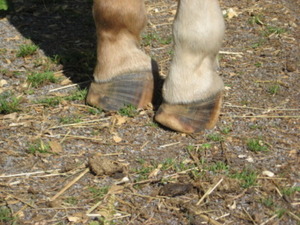On Farm Physical
 Monday, November 3, 2014
Monday, November 3, 2014 What Every Horse Owner Should Know….
As you head out to feed your horse in the evening you notice that he/she has some dirt or shavings on their back and this morning’s hay is still on the ground. He doesn’t seem interested in dinner and instead starts pawing and rolling on the ground.
Its time to call your veterinarian and they may ask you to check your horse’s heart rate, gut sounds and mucous membrane color.
Knowing how to perform a basic physical examination is a skill every horse owner should know. It is also important to know your horses' normal vital signs. Horse’s have a wide range of normal values for physical exam parameters, and it is useful to compare values in an emergency to your horses' known normal values. As a general rule, the equine heart rate ranges from 32-44 beats per min (bpm), respiratory (breath) rate between 8-16 breaths per min (bpm), and normal temperature between 99.5°-101.5°F.
To take your horse's heart rate, place a stethoscope just behind their elbow on the left side of their chest. You will hear a "lub-dub", which constitutes one heart beat. You can also use their pulse to estimate their heart rate. Feel under the round aspect of the back of the jaw and you will feel a round artery and vein. Place light pressure with your fingertips until you can feel a pulse.
To take your horse's respiratory rate, you can watch the rise and fall of their chest or abdominal wall with their breaths. In normal horses it may be a subtle movement. You can also place your hand just in front of the horse’s nostril and feel for the breath on your palm, though some horses may increase their respiratory rate due to something in front of their face.
To take your horse's temperature, stand behind them and to the side. Gently lift their tail, and insert a lubed thermometer into their rectum. If you have a non digital thermometer, be sure to hold it in place or tie a string from the thermometer to their tail and leave in place for a full 2 minutes. Make sure you stand in a safe position, as some horses will kick during this procedure.
Some other parameters that are good to look at include mucous membranes. To look at a horse’s mucous membranes, gently flip their upper lip and look at their gums. Normally their gums should be light pink and moist. You also can check a capillary refill time (CRT), which is an indicator of systemic perfusion. To do this, press your thumb into their gum until the tissue underneath it blanches white. Then release the pressure and count how many seconds it takes for the pink color to return to the area. Normal CRT is less than 2 seconds.
Gastrointestinal sounds (Gut sounds) are another parameter that your veterinarian may ask you to listen to. They can vary between horses and depending on time of day and what they are being fed. The best way to learn what your horse’s normal gut sounds are is to listen to them at least once a season (green grass gurgles, normal pasture noises, grain gas bubbles, etc). Gut sounds are particularly useful in colic cases, where gut sounds may be increased or decreased.
Digital pulses are a key parameter, particularly in laminitis or lameness cases. To feel for digital pulses, feel on the outside of the pastern about mid between the coronary band and fetlock for a group of round structures. Palpate gently over this area to see whether you feel a pulse. It is common to not feel digital pulses in normal horses, but very strong pulses to their hooves can indicate a problem.
By performing a brief physical examination on your horse, you can provide important information to your veterinarian before they are able to reach the farm, and give some direction as to whether there are any treatments that can be initiated immediately. However, always be sure to contact a veterinarian before administering any medications or starting treatment.
 Email Article Comments Off
Email Article Comments Off 



